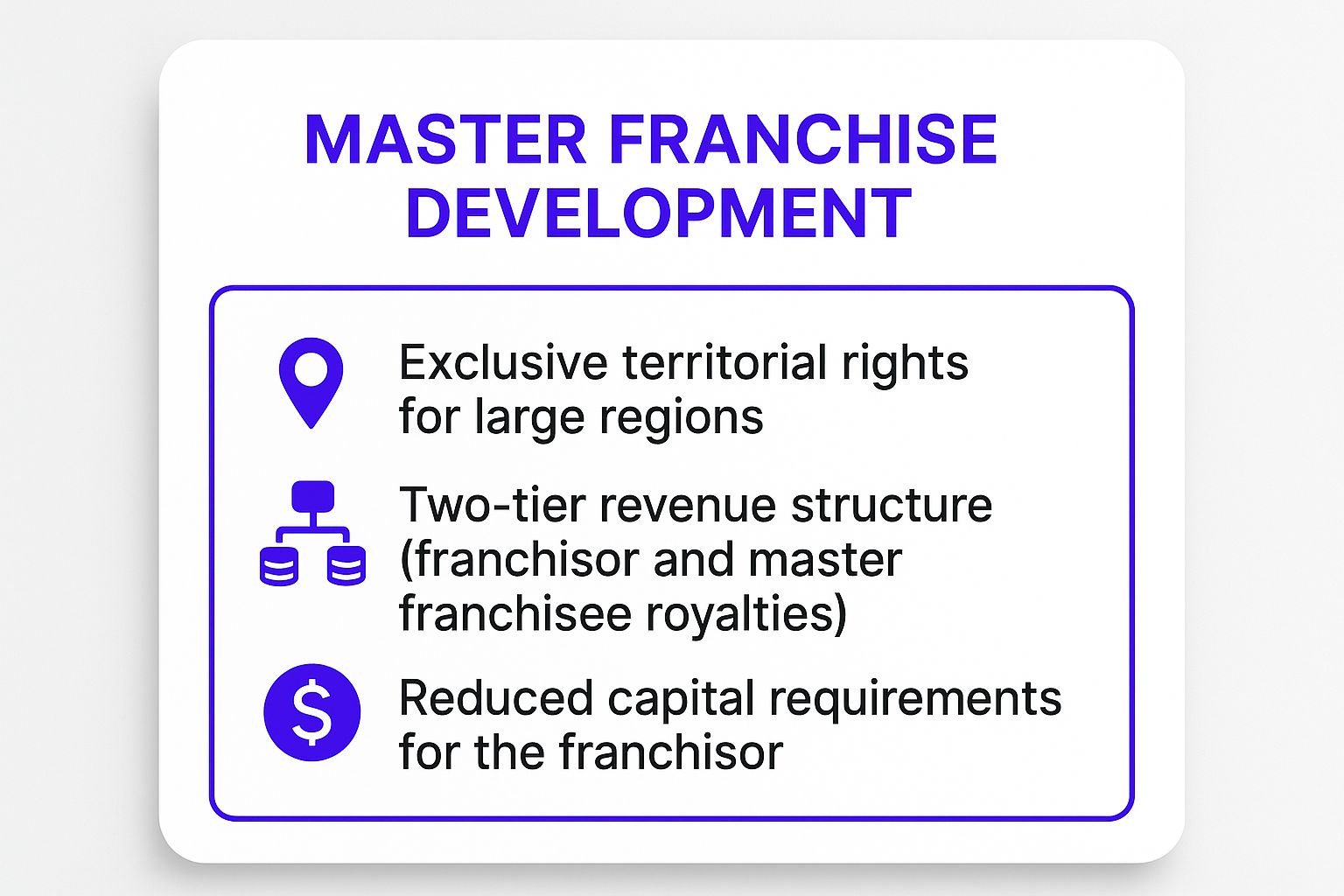Expanding a home service franchise requires more than just hard work; it demands smart, strategic planning. The path from a single successful unit to a thriving multi-location empire is paved with calculated decisions and proven expansion models. Moving beyond generic advice, this guide provides a deep dive into nine powerful franchise growth strategies tailored for the unique challenges and opportunities within the home service industry.
Whether you're aiming to dominate a local market or expand nationally, understanding the fundamental principles of scaling is crucial. To help unlock your franchise's full potential, consider exploring these 10 Proven Strategies for Small Business Growth, which offer a solid foundation for any expansion plan. The frameworks in this article will build upon those core concepts, providing the specific blueprint you need for franchise success.
We'll explore everything from leveraging proven operators for multi-unit development to pioneering digital-first models that reduce overhead and maximize reach. Each strategy is designed to be actionable, ensuring you have the tools to build a sustainable and profitable network. Let's examine the specific models that can transform your business from a local success into a regional powerhouse.
1. Master Franchise Development: Accelerate Expansion with Regional Experts
For home service franchisors aiming for rapid, large-scale growth, especially across state lines or internationally, one of the most powerful franchise growth strategies is Master Franchise Development. This model involves granting an experienced partner, or "master franchisee," the exclusive rights to develop an entire territory. Instead of you shouldering the burden of recruiting and training every unit franchisee, the master franchisee acts as a regional extension of your brand.
This partner invests their own capital and leverages their local market expertise to recruit, train, and support sub-franchisees within their designated area. In return, you receive an initial master franchise fee and ongoing royalty payments from their network's revenue. This approach significantly lowers your direct operational costs and capital investment while accelerating market penetration. For a home service brand, a master franchisee with deep connections in a new state can navigate local licensing, labor laws, and marketing channels far more effectively than an outside company could.
Key Implementation Steps
Successfully implementing a master franchise model requires a meticulous approach to partner selection and system development. Focus on establishing a strong foundation to ensure brand consistency and long-term success.
- Vet Candidates Rigorously: Prioritize candidates with proven business acumen, substantial financial backing, and intimate knowledge of the target territory. Their expertise is the cornerstone of this strategy.
- Define Clear Performance Metrics: Your Master Franchise Agreement must include a detailed development schedule with specific timelines for opening a minimum number of units. This ensures your partner is actively growing the brand.
- Build a Robust Support System: Create a comprehensive training program specifically for master franchisees, covering not just your operational systems but also how to effectively recruit, train, and support their own sub-franchisees.
The infographic below highlights the core components that make this model a powerful vehicle for expansion.

These three elements work together to create a scalable system where your brand can grow exponentially with reduced direct capital outlay and operational strain.
2. Multi-Unit Development Strategy: Grow with Your Top Performers
One of the most reliable franchise growth strategies involves looking inward and empowering your best existing franchisees to expand their portfolios. The Multi-Unit Development Strategy focuses on granting top-performing single-unit owners the rights to open additional locations. This approach leverages their proven operational excellence, deep brand knowledge, and established financial stability to fuel expansion while significantly mitigating the risks associated with bringing in new, unproven operators.
This model allows you to scale your brand with partners who have already demonstrated their commitment and capability. Instead of gambling on new franchisees, you are investing in a known quantity. For a home service brand, a successful franchisee who has mastered the local market, built a strong team, and perfected customer service is the ideal candidate to replicate that success in neighboring territories. This ensures operational consistency and upholds brand standards as you grow.
Key Implementation Steps
A successful multi-unit strategy depends on identifying the right operators and providing them with the necessary framework and support to manage a larger enterprise. Your goal is to make the transition from single-unit owner to multi-unit empire builder as seamless as possible.
- Identify Top Operators Early: Proactively monitor performance data to pinpoint franchisees who consistently exceed KPIs, demonstrate strong leadership, and possess the financial capacity for expansion.
- Create Tiered Incentive Programs: Develop attractive financial incentives for multi-unit development, such as reduced franchise fees or tiered royalty structures for subsequent locations. This makes expansion a compelling business proposition.
- Establish Clear Development Agreements: Your multi-unit agreement must define exclusive territory rights and include a clear, achievable development schedule. This ensures momentum and prevents territory squatting.
By focusing on your proven winners, you create a scalable growth model built on a foundation of operational excellence and shared success.
3. Conversion Franchising: Grow by Bringing Independents into the Fold
One of the most effective franchise growth strategies for established home service brands is Conversion Franchising. This approach targets existing independent businesses in your industry, such as a local plumbing or HVAC company, and converts them into a franchise unit. Instead of starting from scratch, you absorb an operation with a pre-existing customer base, trained staff, and a proven local reputation, rebranding it under your system. This strategy accelerates market presence and adds seasoned operators to your network.
This model provides a win-win scenario. The independent owner gains access to your established brand recognition, sophisticated marketing systems, operational support, and bulk purchasing power. In return, you gain an immediate revenue stream and a foothold in a new market without the typical startup risks and timelines. For instance, an independent cleaning service already has clients and equipment; converting them simply integrates your superior branding and systems to elevate their business and expand your footprint.
Key Implementation Steps
A successful conversion strategy hinges on a smooth, supportive, and compelling transition process. The goal is to demonstrate undeniable value to the independent owner, making the switch an obvious step forward for their business.
- Develop a Compelling Value Proposition: Clearly articulate the benefits of joining your system, such as increased lead generation, better technology, and stronger profit margins. Offer financial incentives like reduced initial franchise fees or royalty rates for a limited time.
- Create a Seamless Transition Plan: Design a comprehensive onboarding program specifically for converting businesses. This plan must cover rebranding, technology integration, staff training, and a marketing strategy to announce the change to existing customers.
- Identify and Target the Right Businesses: Focus on established, reputable independent operators whose company culture and service quality align with your brand standards. A strong operator with a weak brand is a perfect conversion candidate.
4. Non-Traditional Location Strategy: Capture High-Traffic Audiences
One of the most innovative franchise growth strategies is moving beyond traditional storefronts and into non-traditional locations. This approach involves placing smaller, often specialized, outlets in high-traffic, captive-audience environments like airports, universities, hospitals, and large retail stores. Instead of waiting for customers to come to you, you establish a presence directly in their path, capitalizing on convenience and impulse decisions.
For a home service franchise, this could mean setting up a kiosk in a home improvement store like The Home Depot or a booth at a large community event. This strategy allows your brand to engage with potential customers in the exact moment they are thinking about home projects, offering consultations or scheduling services on the spot. It's an effective way to generate leads and build brand awareness with a lower initial investment than a full-sized brick-and-mortar location, directly targeting a relevant audience.
Key Implementation Steps
Successfully launching in non-traditional venues requires adaptability and strategic partnerships. The focus is on creating a streamlined operational model that fits seamlessly into a host environment while maximizing customer engagement.
- Develop Standardized Small-Format Models: Design a compact, efficient operational footprint. This could be a kiosk or a small booth with portable equipment, optimized for quick setup and minimal staffing, ensuring profitability in a smaller space.
- Build Relationships with Venue Managers: Proactively network with property managers of airports, hospitals, or major retail centers. A strong relationship is key to securing prime locations and navigating the specific operational rules of each venue.
- Analyze Traffic and Customer Behavior: Before committing, study the foot traffic patterns and demographics of a potential venue. Tailor your service offerings and marketing messages to align with the needs and mindset of the audience you'll encounter there.
5. Digital-First Franchise Model: Expand Without the Footprint
A modern and highly scalable franchise growth strategy involves adopting a digital-first model. This approach leverages technology, delivery services, and sometimes "ghost kitchens" to expand brand presence without the significant overhead of traditional brick-and-mortar locations. It prioritizes online ordering, efficient delivery fulfillment, and digital marketing to reach customers where they are, offering a lean and agile way to penetrate new markets.
This model is especially potent for brands whose services or products are deliverable. It minimizes upfront investment in real estate and build-out costs, allowing for faster scaling and greater flexibility. For home service franchises, this might mean a centralized hub managing digitally dispatched technicians or a product-based brand using local fulfillment centers. Companies like Wow Bao have perfected this by expanding their food concept into existing kitchens, proving a brand can grow exponentially with minimal physical infrastructure.

Key Implementation Steps
Success with a digital-first model hinges on a seamless technological infrastructure and strategic partnerships. The focus shifts from physical location management to optimizing the online customer journey and fulfillment logistics.
- Invest in a Robust Tech Stack: A user-friendly online ordering platform, a reliable CRM, and an efficient dispatching system are non-negotiable. The digital experience is your storefront.
- Forge Strong Delivery Partnerships: If applicable, partner with reputable third-party delivery services to ensure your brand's quality standards are maintained from order to doorstep.
- Master Digital Marketing: Your growth is directly tied to your online visibility. Implement targeted digital advertising, SEO, and social media strategies to capture local demand and build brand recognition in new territories.
6. Strategic Partnership Development: Amplify Reach Through Collaboration
One of the most innovative franchise growth strategies involves forming strategic alliances with complementary, non-competing businesses. This approach accelerates expansion by tapping into an established customer base, reducing marketing costs, and enhancing your service offerings. Instead of building brand awareness from scratch in a new area, you leverage the trust and loyalty another business has already cultivated.
For a home service franchise, this could mean partnering with a reputable real estate agency, a property management company, or a network of interior designers. These partners can refer your services to their clients at the exact moment of need, creating a powerful and cost-effective customer acquisition channel. The partnership is mutually beneficial: you gain direct access to qualified leads, while your partner adds value for their clients by recommending a trusted service provider.

Key Implementation Steps
A successful partnership strategy hinges on finding the right fit and establishing clear, mutually beneficial terms. The goal is to create a seamless experience for the customer and a profitable arrangement for both businesses.
- Identify Aligned Partners: Look for businesses whose customer demographics and brand values mirror your own. A high-end cleaning franchise, for example, would align better with a luxury real estate brokerage than a budget-focused property manager.
- Establish Clear Agreements: Formalize the partnership with a detailed agreement that outlines referral processes, commission structures, co-marketing responsibilities, and performance metrics. This prevents misunderstandings and ensures both parties are accountable.
- Develop Joint Marketing Initiatives: Create co-branded marketing materials, such as flyers, email campaigns, or social media content, that highlight the benefits of your combined services. This reinforces the partnership and builds credibility with potential customers.
7. Micro-Franchise Development: Empowering Growth in Untapped Markets
For home service franchisors looking to expand into new or underserved communities, Micro-Franchise Development offers an innovative and impactful growth strategy. This model involves creating a scaled-down, low-cost version of your business designed for entrepreneurs in markets that cannot support a traditional, high-investment franchise. It prioritizes simplicity, affordability, and social impact, opening doors for rapid expansion where other models might fail.
Instead of a full-scale operation, a micro-franchise might offer a limited, high-demand service, such as basic lawn mowing or junk removal, with minimal equipment and overhead. This approach dramatically lowers the barrier to entry, empowering local entrepreneurs to start a business while extending your brand's reach. You receive a smaller initial fee and ongoing royalties, but the volume of new units can lead to significant cumulative growth and positive community engagement.
Key Implementation Steps
Successfully launching a micro-franchise program requires redesigning your model for maximum accessibility and support. The focus shifts from high-revenue units to high-volume, community-integrated businesses that collectively strengthen your brand presence.
- Simplify Your Operational Model: Develop an ultra-streamlined version of your business focused on core, high-demand services. Create simplified training programs and operational manuals that are easy for new entrepreneurs to follow.
- Establish Accessible Financing: The low-cost nature of this model is its key advantage. Partner with micro-finance institutions or create flexible internal financing options to make business ownership attainable for a wider range of candidates.
- Build Local Support Networks: Forge partnerships with community organizations to assist with franchisee recruitment, training, and ongoing support. This hyper-local approach ensures your micro-franchisees are set up for success from day one.
8. Acquisition and Integration Strategy: Grow by Buying, Not Just Building
For established franchisors with significant capital, one of the most aggressive franchise growth strategies is acquiring other businesses. This approach involves purchasing a competitive brand, an independent local chain, or even a complementary service provider and integrating it into your existing system. This strategy allows you to gain an immediate market share, acquire a proven customer base, and eliminate a competitor in a single transaction.
Instead of building new locations from the ground up, you absorb an existing network. This could mean converting the acquired company’s locations to your brand or operating it as a distinct entity within your portfolio. For a home service franchise, this might look like acquiring a successful local plumbing company to add a new service line or buying out a smaller, regional competitor to rapidly expand your geographic footprint. This method provides an instant injection of revenue, talent, and operational infrastructure.
Key Implementation Steps
A successful acquisition and integration strategy hinges on meticulous planning and execution. The process is complex and requires a clear vision for how the two entities will merge to create value without disrupting franchisee and customer relationships.
- Conduct Thorough Due Diligence: Go beyond the balance sheet. Investigate the target's franchisee satisfaction levels, brand reputation, operational systems, and cultural alignment. A seemingly good deal can quickly sour if the franchisee network is unhappy or the brand has underlying issues.
- Develop a Comprehensive Integration Plan: Create a detailed roadmap outlining how you will merge operations, technology, marketing, and company culture. Define clear timelines and responsibilities, ensuring a smooth transition for employees, franchisees, and customers.
- Communicate Transparently and Proactively: Keep all stakeholders, especially the franchisees from both systems, informed throughout the process. Clear, consistent communication can mitigate fear and uncertainty, fostering buy-in for the new, combined vision.
9. Franchise Recruitment Marketing Excellence
Sustainable franchise growth hinges on a consistent influx of high-quality franchisee candidates. This is where Franchise Recruitment Marketing Excellence comes in, a strategy that transforms your recruitment process from a reactive task into a sophisticated, proactive system. It involves a multi-channel approach that leverages digital marketing, data analytics, and targeted outreach to build a robust pipeline of ideal partners who are not just financially qualified, but culturally aligned with your brand.
For a home service franchise, this means moving beyond generic advertisements and creating a compelling narrative that attracts entrepreneurs passionate about your specific niche, whether it's elder care, landscaping, or HVAC services. By developing detailed ideal candidate profiles, you can tailor your messaging and channels to reach them effectively. For instance, Home Instead strategically targets individuals with a background in healthcare or community service, ensuring new franchisees share their mission-driven values. This is one of the most fundamental franchise growth strategies for building a strong, unified network.
Key Implementation Steps
Implementing an excellent recruitment marketing system requires a deliberate and data-driven approach. The goal is to create a seamless and persuasive journey for every prospective franchisee, from their first click to signing the franchise agreement.
- Develop Ideal Franchisee Profiles: Create detailed personas for your perfect franchisee, including their professional background, financial standing, motivations, and values. Use these profiles to guide all your marketing efforts.
- Invest in a Professional Digital Presence: Your franchise development website is your primary recruitment tool. Ensure it has a professional design, compelling content, clear calls-to-action, and efficient lead capture forms. Crafting the best Google Ads landing pages for lead generation is essential for converting clicks into high-quality inquiries.
- Implement a CRM for Nurturing: Use a Customer Relationship Management (CRM) system to track and nurture every lead through a structured discovery process. This ensures no potential candidate falls through the cracks and allows for personalized, timely communication.
- Create Compelling Marketing Collateral: Develop a suite of high-quality materials, including a detailed franchise disclosure document (FDD), informational brochures, video testimonials from existing franchisees, and webinars that clearly articulate your brand's value proposition.
By systemizing your recruitment, you can attract better-qualified candidates who are more likely to succeed, directly fueling long-term, healthy brand expansion. You can learn more about how to attract these high-quality candidates on phonestaffer.com.
Franchise Growth Strategies: 9-Point Comparison
| Franchise Growth Strategy | 🔄 Implementation Complexity | 💡 Resource Requirements | 📊 Expected Outcomes | ⭐ Key Advantages | ⚡ Ideal Use Cases |
|---|---|---|---|---|---|
| Master Franchise Development | High – managing master franchisee & sub-franchisees | Moderate – requires thorough vetting and support | Rapid international expansion with shared risk | Local market expertise, faster penetration | Large geographic expansion, international markets |
| Multi-Unit Development Strategy | Medium – coordinating phased openings & multi-unit operators | Moderate – needs strong operational support | Faster territory saturation, economies of scale | Proven operators, reduced recruitment costs | Established markets with experienced franchisees |
| Conversion Franchising | Medium-High – converting existing businesses | Moderate-High – incentives and transition support | Rapid expansion via established locations | Immediate revenue, access to existing customer base | Markets with independent operators or competitors |
| Non-Traditional Location Strategy | Medium – specialized operations & approvals | Moderate – smaller footprint, operational adjustments | Access to captive, high-traffic customers | Lower real estate cost, extended hours | Airports, hospitals, universities, malls |
| Digital-First Franchise Model | High – tech infrastructure and delivery logistics | High – digital platforms and data analytics | Rapid digital market entry, broad reach | Low overhead, data-driven insights | Delivery-focused, online-first food service brands |
| Strategic Partnership Development | High – managing alliances and co-branding | Moderate – partnership agreements & joint efforts | Accelerated expansion through partners | Cost reduction, enhanced customer value | Co-branded locations, integrated services |
| Micro-Franchise Development | Medium – simplified models for underserved markets | Low to Moderate – low investment models | High volume growth in emerging markets | Low barrier entry, social impact | Emerging or underserved markets |
| Acquisition and Integration Strategy | Very High – complex acquisitions & integrations | High – financial and management resources | Immediate market share growth and consolidation | Eliminates competition, economies of scale | Rapid expansion via acquisition |
| Franchise Recruitment Marketing Excellence | Medium – data-driven marketing & candidate qualification | High – marketing infrastructure & professional teams | Higher quality franchisee pipeline | Scalable recruitment, improved success rates | Attracting qualified franchisees in competitive markets |
Choosing Your Blueprint for Sustainable Growth
Navigating the landscape of franchise expansion requires more than just ambition; it demands a strategic, well-defined blueprint. The nine franchise growth strategies detailed in this article, from Master Franchise Development to Franchise Recruitment Marketing Excellence, are not mutually exclusive options but rather powerful tools in your arsenal. The most successful home service franchisors rarely rely on a single path. Instead, they create a dynamic, multi-faceted approach tailored to their specific market conditions, capital availability, and long-term vision.
The journey from a single successful unit to a sprawling, thriving network is built on intentional decisions. Your ideal path might involve blending a Multi-Unit Development Strategy to deepen your penetration in established territories while simultaneously exploring Conversion Franchising to accelerate your brand's footprint with experienced operators. Each strategy offers a unique set of advantages, whether it's the rapid market entry of a Master Franchisee or the capital-efficient expansion offered by a Digital-First Franchise Model.
From Theory to Action: Building Your Roadmap
The true value of understanding these models lies in their application. Your immediate task is to move from learning to planning. Begin by evaluating your current business standing and future goals against the frameworks we've discussed.
- Assess Your Capital and Risk Tolerance: Are you positioned for a high-investment, high-reward strategy like Acquisition and Integration, or does a lower-capital model like Micro-Franchise Development better suit your current phase?
- Analyze Your Brand Maturity: Is your brand strong enough to attract sophisticated investors for multi-unit deals, or would focusing on Strategic Partnership Development help build credibility first?
- Define Your Growth Velocity: Are you aiming for explosive, rapid expansion, or a more measured, sustainable build-out? Your answer will guide whether you prioritize speed-to-market strategies or those focused on deep, regional dominance.
Mastering these franchise growth strategies is about more than just scaling your operations; it's about building a resilient, adaptable, and profitable enterprise that can withstand market shifts and consistently deliver value. The right combination of strategies, executed with precision and a deep understanding of your brand, will transform your growth aspirations into a tangible, market-leading reality. The blueprint is here; the next step is to start building.
As you scale, ensuring every lead is captured and every customer receives exceptional service becomes paramount to your brand's reputation. Don't let growth overwhelm your administrative capacity. Discover how Phone Staffer provides dedicated, professionally trained virtual receptionists to manage your calls, book appointments, and support your franchisees, so you can focus on strategic expansion.

